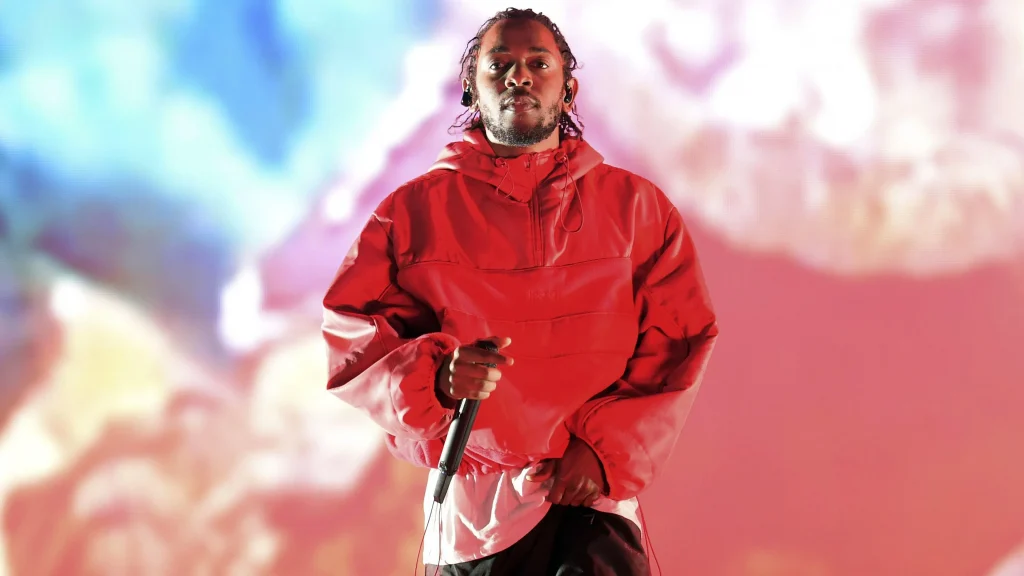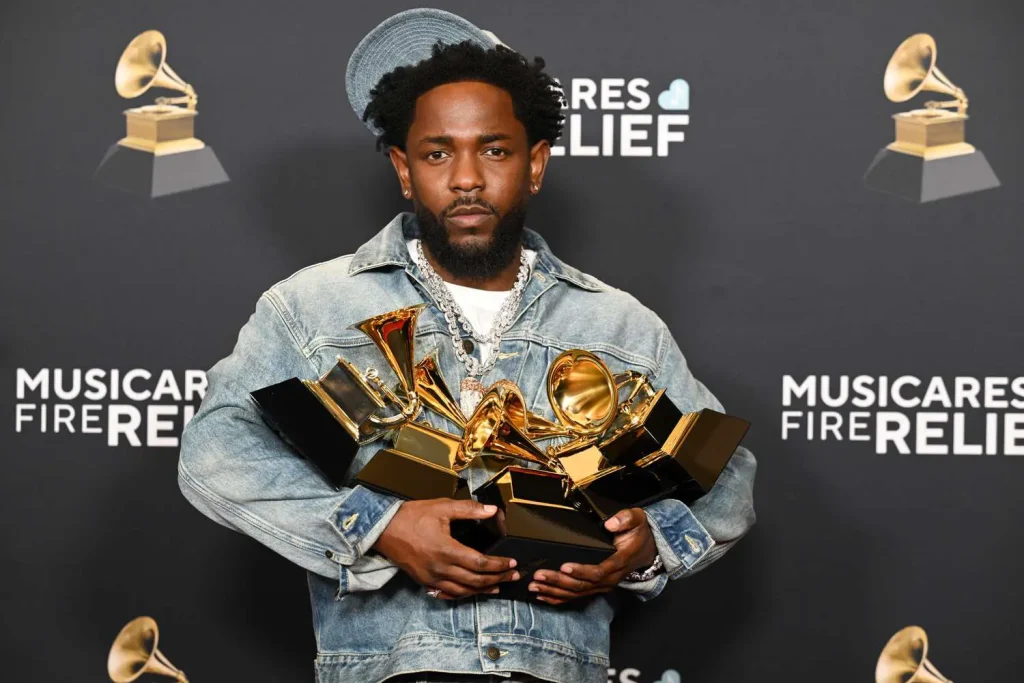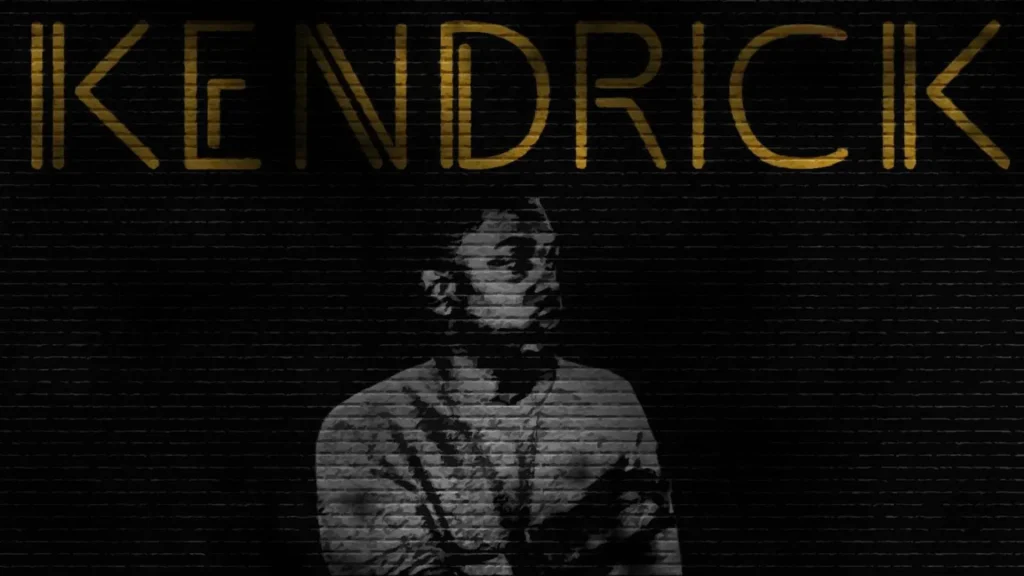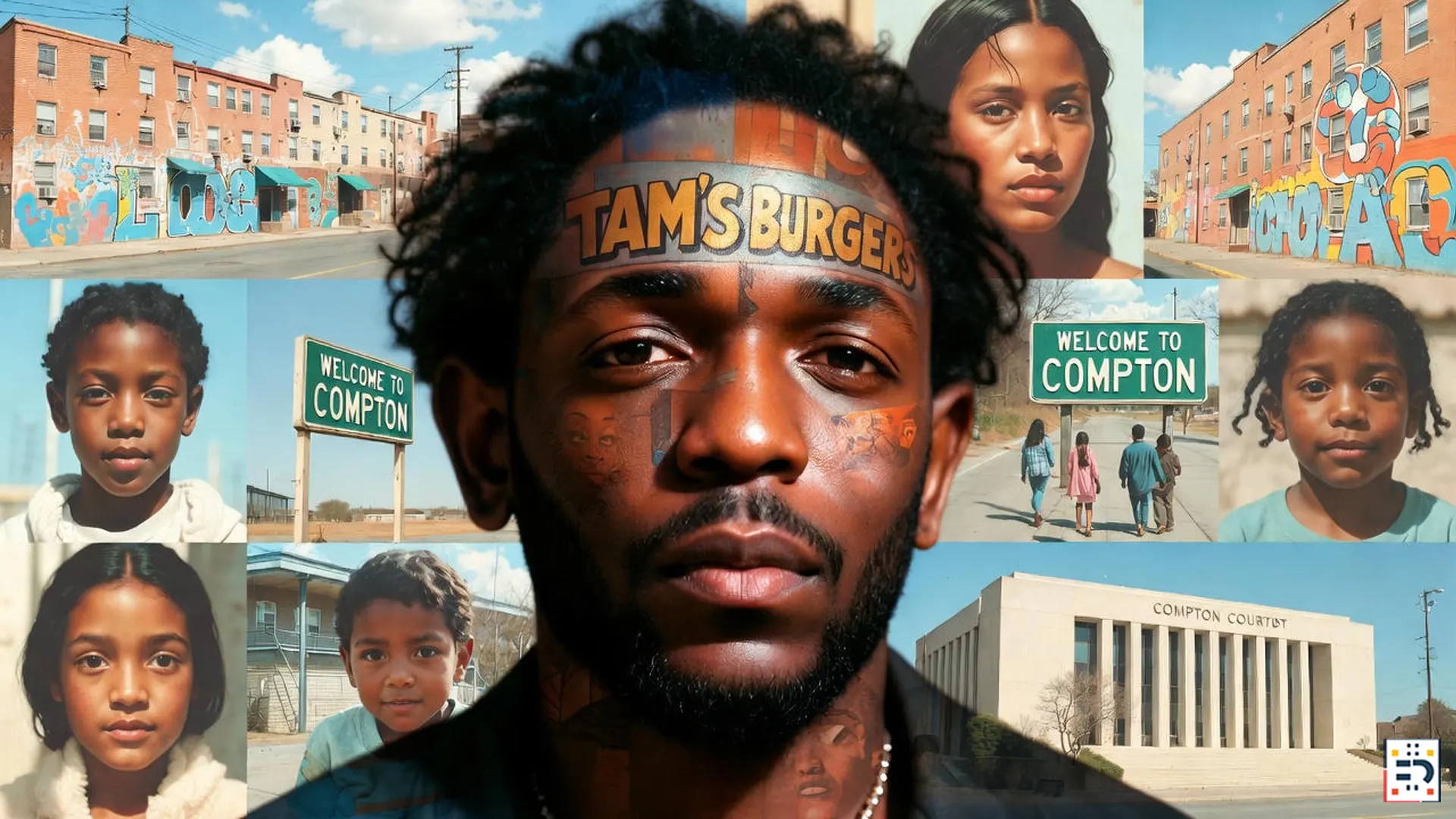Introduction: More Than Just a Hometown
When Kendrick Lamar headlined Super Bowl LIX in February 2025, performing his Drake diss track “Not Like Us” on the world’s biggest stage, he didn’t just represent himself—he represented Compton, California, the city that forged one of hip-hop’s most influential voices. With 9 Grammy nominations for the 2026 awards, including his fifth consecutive album of the year nomination for “GNX,” Kendrick continues to carry Compton’s legacy forward in unprecedented ways.
Born Kendrick Lamar Duckworth on June 17, 1987, in Compton’s west side, the rapper inherited more than a zip code. He inherited a complex narrative of struggle, survival, and cultural transformation that would become the foundation of his artistry. Understanding Kendrick Lamar’s music means understanding that Compton isn’t just where he comes from—it’s the lens through which he views the world, the rhythm that pulses through his verses, and the conscience that refuses to let him forget his roots.

Compton’s Complex Identity: Beyond the Stereotypes
The City That Birthed West Coast Hip-Hop
Compton’s reputation in American culture is complicated. During Kendrick’s childhood in the late 1980s and 1990s, the city became synonymous with gang violence, the crack epidemic, and the explosive birth of gangsta rap. Legendary groups like N.W.A. had already put Compton on the global map with their raw, unflinching portrayal of street life, and young Kendrick grew up in the aftermath of that cultural explosion.
But to truly understand Kendrick’s Pulitzer Prize-winning artistry is to recognize that Compton transcends its stereotypes. It’s a community of working families striving to survive, dreamers who refuse to be defined by systemic neglect, and a culture rich with Black excellence despite decades of disinvestment. In his music, Kendrick paints Compton in all its complexity—acknowledging both its beauty and its brutality.
The Duality of Home
On tracks like “Compton” featuring Dr. Dre, Kendrick raps with unmistakable pride about his hometown while never shying away from its hardships. This duality permeates every Kendrick Lamar album: Compton is a place that threatens to consume you while simultaneously giving you the strength to overcome anything. It’s this honest, nuanced perspective that separates Kendrick from many of his hip-hop contemporaries.
The Streets as Classroom: How Compton Educated a Poet
Growing Up in Section 8 Housing
Kendrick and his family lived in Section 8 housing, relied on welfare and food stamps, and experienced periods of homelessness. His childhood experiences in Compton became his education in human nature, survival ethics, and moral philosophy. He witnessed violence firsthand—including a murder outside his apartment at just five years old—lost friends to gang activity, and navigated an environment where a single wrong decision could cost you your life.
These weren’t abstract concepts studied in books. They were Kendrick’s daily reality, and they permeate his masterwork “good kid, m.A.A.d city,” which functions as a cinematic narrative of a teenager navigating Compton’s dangers.

Authenticity Through Specificity
Songs like “The Art of Peer Pressure” and “m.A.A.d city” recreate the atmosphere of Compton’s streets with visceral detail. The album’s skits feature his actual parents’ voices, grounding the narrative in authentic experience. When Kendrick raps about being a “good kid” in a “mad city,” he’s describing the cognitive dissonance millions face: trying to maintain your moral center when chaos surrounds you.
The geographical precision matters tremendously. Kendrick doesn’t rap about generic street life—he mentions actual Compton landmarks, from Rosecrans Avenue to Tam’s Burgers, from Centennial High School to his mother’s van. This hip-hop storytelling transforms his music into oral history, documenting a time and place that mainstream America often ignored or misunderstood.
2024-2025: Kendrick’s Continued Compton Commitment
Giving Back to the Community
In June 2024, Kendrick made a surprise appearance at Compton College’s commencement ceremony, telling graduates: “I’m proud of the city of Compton, I’m proud of Compton College, most importantly I’m proud of the graduates out here”. His message resonated deeply: this Compton degree is just as valuable as any Ivy League diploma.
Following his historic ‘Pop Out’ concert on Juneteenth 2024, Lamar and collaborators donated $200,000 to charities and community outreach programs based in Los Angeles. This continues his pattern of philanthropic investment in Compton, including his 2013 donation of $50,000 to Centennial High School’s music program and regular participation in the annual Compton Christmas toy drive.
The “Not Like Us” Phenomenon
“Not Like Us,” Kendrick’s Drake diss track, won Song of the Year, Best Rap Song, Best Music Video, and Best Rap Performance at the 2025 Grammy Awards. The song became more than a rap battle victory—it became a Compton anthem. When filming the music video in June 2024, over 700 residents gathered at the Compton courthouse to participate, demonstrating the city’s pride in their native son.
GNX Album and Continued Evolution
Kendrick’s surprise November 2024 album “GNX” continues his tradition of representing Compton while pushing artistic boundaries. The album includes “Dodger Blue,” a direct reference to how the Los Angeles Dodgers’ colors have influenced Compton culture, and “wacced out murals,” which addresses current music industry dynamics while staying rooted in his West Coast perspective.
Survivor’s Guilt and Moral Responsibility
The Weight of Success
As Kendrick’s career ascended from Compton’s streets to winning the Pulitzer Prize for Music in 2018, his hometown remained both his anchor and his burden. Success brought profound survivor’s guilt: why did he escape when so many talented individuals didn’t? This question haunts albums like “To Pimp a Butterfly,” where Kendrick wrestles with his responsibility to his community.
On “How Much a Dollar Cost,” he tells a parable about encountering a homeless man who might be God, exploring themes of compassion, materialism, and maintaining your values after escaping poverty. It’s the kind of moral complexity that only someone deeply embedded in Compton’s struggle could articulate with such authority.
Confronting Uncomfortable Truths
“The Blacker the Berry” confronts an even harder question: how can he protest police killings of Black men when gang violence claims Black lives in Compton daily? It’s an uncomfortable reckoning that refuses easy answers, instead holding up a mirror to contradictions within himself and his community. This willingness to explore complexity, rather than offering simple solutions, defines Kendrick’s artistic integrity.

Compton’s Political Awakening in Kendrick’s Music
Growing Up During Systemic Injustice
Growing up in Compton during the 1990s meant witnessing the aftermath of the 1992 Los Angeles riots, living through California’s devastating Three Strikes law that disproportionately affected Black families, and experiencing how systemic racism manifested through failing schools, aggressive policing, and economic disinvestment. These experiences politicized Kendrick’s worldview long before he became a conscious rapper.
“To Pimp a Butterfly”: A Political Masterpiece
On “To Pimp a Butterfly,” Kendrick channels this political consciousness through jazz-infused production that recalls the Black liberation movements of the 1960s and 1970s. “Alright” became an unofficial anthem for Black Lives Matter, not because Kendrick set out to write a protest song, but because he was documenting his truth—and that truth resonated with a national movement.
When he raps “We gon’ be alright,” it’s simultaneously a prayer and a promise rooted in Compton’s survival spirit. The song represents what happens when personal experience meets collective struggle, when one artist’s Compton story becomes America’s story.
DAMN. and the DNA of Compton
His Pulitzer Prize-winning album “DAMN.” further explores the duality of growing up in Compton—the tension between faith and violence, love and fear, nature and nurture. On “DNA.,” he raps “I got power, poison, pain and joy inside my DNA,” acknowledging how Compton’s influence is literally written into his being, passed down through generations of struggle and resilience.
The Voice of a Generation: Kendrick’s Unique Perspective
Refusing Simple Narratives
What makes Kendrick’s Compton-influenced perspective so powerful in contemporary hip-hop is his refusal to perform a single narrative. He’s not just the conscious rapper preaching uplift, nor is he the gangsta rapper glorifying street life. He’s both and neither—a complex human being shaped by a complex place, willing to show all sides of that experience.
This authenticity has made him arguably the most influential rapper of his generation. As an Augusta University lecturer notes, Kendrick has only two real rivals for most influential rapper of this generation: Kanye West and Drake, and Kendrick brings something unique: he’s raised the bar for lyrical delivery and conceptual depth in ways that have fundamentally changed hip-hop’s landscape.
Processing Generational Trauma
His 2022 album “Mr. Morale & The Big Steppers” shows an artist still processing Compton’s impact through new lenses: generational trauma, therapy, mental health, and personal growth. On “Mother I Sober,” he traces how childhood experiences in Compton—including sexual abuse within his extended family—created wounds that took years to understand and address. It’s a level of vulnerability rarely seen in mainstream hip-hop, and it only works because of the foundation of trust Kendrick built by always representing Compton truthfully.

A Love Letter and a Warning
The Complicated Relationship with Home
Kendrick Lamar’s relationship with Compton mirrors many people’s relationships with their hometowns—it’s profoundly complicated. He loves it fiercely, yet recognizes how it scarred him. While proudly representing it on global stages, he critiques the systems that created its problems, for though he escaped physically, he will never leave it spiritually.
His music stands as both a love letter and a warning: a love letter to the people who raised him, the culture that shaped him, and the resilience that defines Compton’s Black community; a warning about the cost of neglecting entire communities, the cycles of violence that trauma perpetuates, and the genius we lose when we fail to invest in our children.
Legacy Beyond the City Limits
Reshaping America’s Perception of Compton
Today, Kendrick’s influence has helped reshape how America sees Compton. He’s not the first great artist from the city—Dr. Dre, DJ Quik, The Game, and many others paved the way. But Kendrick brought a literary depth and philosophical complexity that elevated West Coast hip-hop to unprecedented heights.
He proved you could be from Compton and win a Pulitzer Prize, that street knowledge and artistic genius aren’t contradictions, that conscious hip-hop can dominate mainstream charts. When he was announced as the first solo rapper to headline a Super Bowl halftime show, it represented not just his individual achievement but Compton’s validation on the world’s biggest stage.
The Numbers Tell the Story
Kendrick has earned 22 Grammy Awards throughout his career and has a net worth of approximately $140 million, making him one of the highest-paid rappers in the industry. His first major studio album “Good Kid, M.A.A.D City” sold over 1.1 million copies in the United States and achieved the remarkable feat of charting every single week for years on the Billboard 200—unprecedented longevity that speaks to the album’s cultural impact.
But beyond commercial success, three of his albums were included in Rolling Stone’s 2020 revision of the “500 Greatest Albums of All Time,” cementing his place in music history. Every accolade he earns reflects back on Compton, changing the narrative about what’s possible for kids from underinvested communities.
A City and an Artist Intertwined
When you listen to Kendrick Lamar, you’re not just hearing one man’s story—you’re hearing Compton speak through him. Every bar carries the weight of that city’s history, every album wrestles with its contradictions, and every accolade he earns reflects glory back on the community that made him. From “Section.80” to “GNX,” from local mixtapes to Pulitzer Prizes, from Compton street corners to Super Bowl stadiums, the journey has been extraordinary.
As Kendrick himself stated at the 2024 Compton College graduation: “When I walk out in these cities and these countries, I could be proud and say, this is where I’m from. I still believe in Compton”. That belief is reciprocated. Compton believes in Kendrick just as much as he believes in Compton.
Compton didn’t just influence Kendrick Lamar’s music and worldview—it became inseparable from his artistry, his identity, and his mission. Through his music, Compton’s story—with all its pain, pride, complexity, and humanity—reaches millions worldwide. That’s the ultimate influence: a city and an artist so intertwined that neither can be fully understood without the other.
Frequently Asked Questions
Q: How did Compton influence Kendrick Lamar’s music?
A: Compton provided Kendrick with firsthand experiences of gang violence, poverty, and systemic racism that became the foundation of his storytelling. Growing up in Section 8 housing and witnessing murders, drug addiction, and police brutality gave him authentic material that resonates because it’s lived experience, not performance.
Q: What is Kendrick Lamar’s most successful album?
A: Commercially, “DAMN.” achieved massive success, winning the 2018 Pulitzer Prize for Music and spawning hit singles like “HUMBLE.” However, “good kid, m.A.A.d city” is considered his most influential work for its cinematic storytelling about Compton life.
Q: Does Kendrick Lamar still live in Compton?
A: While Kendrick has purchased homes in other areas, he maintains strong ties to Compton, regularly appearing at community events, donating to local schools and charities, and representing the city in his music and public appearances.
Q: How many Grammy Awards has Kendrick Lamar won?
A: Kendrick has won 22 Grammy Awards and received 9 nominations for the 2026 Grammy Awards, including his fifth consecutive nomination for Album of the Year with “GNX.”
#KendrickLamar #Compton #HipHop #WestCoastRap #GoodKidMaadCity #ToPimpAButterfly #GNX #SuperBowl2025 #PulitzerPrize #ConsciousRap #BlackExcellence #MusicHistory #RapLegend #ComptonRappers #HipHopCulture #KDot #NotLikeUs #GrammyWinner #HipHopStorytelling #RapGenius


